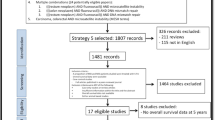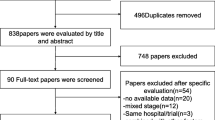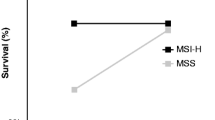Abstract
Introduction
High-frequency microsatellite instability (MSI-H) is an alternate pathway of colorectal carcinogenesis, which accounts for 15% of all sporadic colorectal cancers. These tumours arise from mutations in the DNA mismatch repair system and thus have different responses to chemotherapeutic agents compared to microsatellite stable (MSS) cancers.
Objective
This review aims to summarise the available literature on the responses to chemotherapy in MSI-H colorectal cancer (CRC).
Results and discussion
5 Fluorouracil (5FU) is commonly used as a chemotherapeutic agent in colon cancer and in vitro evidence shows reduced response to 5FU in MSI-H CRC. The clinical evidence is conflicting but favours a reduced response to 5FU in MSI-H CRC. Several newer agents such as COX-2 inhibitors and irinotecan are also reviewed.
Conclusion
Available evidence suggests that MSI-H CRC have different behaviour patterns and response to chemotherapy compared with MSS CRC.


Similar content being viewed by others
References
Aaltonen LA, Peltomaki P, Leach FS et al (1993) Clues to the pathogenesis of familial colorectal cancer. Science 260(5109):812–816
Gryfe R, Kim H, Hsieh ETK et al (2000) Tumor microsatellite instability and clinical outcome in young patients with colorectal cancer. N Engl J Med 342(2):69–77
Hemminki A, Mecklin JP, Jarvinen H et al (2000) Microsatellite instability is a favorable prognostic indicator in patients with colorectal cancer receiving chemotherapy. Gastroenterology 119(4):921–928
Thibodeau SN, Bren G, Schaid D (1993) Microsatellite instability in cancer of the proximal colon. Science 260(5109):816–819
Fearon ER, Cho KR, Nigro JM et al (1990) Identification of a chromosome 18q gene that is altered in colorectal cancers. Science 247(4938):49–56
Lindblom A, Tannergard P, Werelius B et al (1993) Genetic mapping of a second locus predisposing to hereditary non-polyposis colon cancer. Nat Genet 5(3):279–282
Peltomaki P, Aaltonen LA, Sistonen P et al (1993) Genetic mapping of a locus predisposing to human colorectal cancer (comment). Science 260(5109):810–812
Bronner CE, Baker SM, Morrison PT et al (1994) Mutation in the DNA mismatch repair gene homologue hMLH1 is associated with hereditary non-polyposis colon cancer. Nature 368(6468):258–261
Liu B, Nicolaides NC, Markowitz S et al (1995) Mismatch repair gene defects in sporadic colorectal cancers with microsatellite instability. Nat Genet 9(1):48–55
Moslein G, Tester DJ, Lindor NM et al (1996) Microsatellite instability and mutation analysis of hmsh2 and hmlh1 in patients with sporadic, familial and hereditary colorectal cancer. Hum Mol Genet 5(9):1245–1252
Thibodeau SN, French AJ, Cunningham JM et al (1998) Microsatellite instability in colorectal cancer: different mutator phenotypes and the principal involvement of hMLH1. Cancer Res 58(8):1713–1718
Herman JG, Umar A, Polyak K et al (1998) Incidence and functional consequences of hmlh1 promoter hypermethylation in colorectal carcinoma. Proc Natl Acad Sci USA 95(12):6870–6875
Cunningham JM, Christensen ER, Tester DJ et al (1998) Hypermethylation of the hMLH1 promoter in colon cancer with microsatellite instability. Cancer Res 58(15):3455–3460
Markowitz S, Wang J, Myeroff L et al (1995) Inactivation of the type II TGF-beta receptor in colon cancer cells with microsatellite instability. Science 268(5215):1336–1338
Souza RF, Appel R, Yin J et al (1996) Microsatellite instability in the insulin-like growth factor II receptor gene in gastrointestinal tumours (published erratum in Nat Genet 14:488). Nat Genet 14(3):255–257
Parsons R, Myeroff LL, Liu B et al (1995) Microsatellite instability and mutations of the transforming growth factor beta type II receptor gene in colorectal cancer. Cancer Res 55(23):5548–5550
Biswas S, Chytil A, Washington K et al (2004) Transforming growth factor beta receptor type II inactivation promotes the establishment and progression of colon cancer. Cancer Res 64(14):4687–4692
Hahm KB, Lee KM, Kim YB et al (2002) Conditional loss of TGF-beta signalling leads to increased susceptibility to gastrointestinal carcinogenesis in mice. Aliment Pharmacol Ther 16(Suppl 2):115–127
Grady WM, Rajput A, Myeroff L et al (1998) Mutation of the type II transforming growth factor-beta receptor is coincident with the transformation of human colon adenomas to malignant carcinomas. Cancer Res 58(14):3101–3104
Ionov Y, Peinado MA, Malkhosyan S et al (1993) Ubiquitous somatic mutations in simple repeated sequences reveal a new mechanism for colonic carcinogenesis. Nature 363(6429):558–561
Kim HG, Jen J, Vogelstein B et al (1994) Clinical and pathological characteristics of sporadic colorectal carcinomas with DNA replication errors in microsatellite sequences. Am J Pathol 145(1):148–156
Lothe RA, Peltomaki P, Meling GI et al (1993) Genomic instability in colorectal cancer: relationship to clinicopathological variables and family history. Cancer Res 53(24):5849–5852
Jass JR, Do KA, Simms LA et al (1998) Morphology of sporadic colorectal cancer with DNA replication errors. Gut 42(5):673–679
Aaltonen LA, Salovaara R, Kristo P et al (1998) Incidence of hereditary nonpolyposis colorectal cancer and the feasibility of molecular screening for the disease. N Engl J Med 338(21):1481–1487
Bocker T, Schlegel J, Kullmann F et al (1996) Genomic instability in colorectal carcinomas—comparison of different evaluation methods and their biological significance. J Pathol 179(1):15–19
Halling KC, French AJ, McDonnell SK et al (1999) Microsatellite instability and 8p allelic imbalance in stage B2 and C colorectal cancers (see comment). J Natl Cancer Inst 91(15):1295–1303
Powell SM, Zilz N, Beazer-Barclay Y et al (1992) APC mutations occur early during colorectal tumorigenesis. Nature 359(6392):235–237
Aaltonen LA, Peltomaki P, Mecklin JP et al (1994) Replication errors in benign and malignant tumors from hereditary nonpolyposis colorectal cancer patients. Cancer Res 54(7):1645–1648
Konishi M, Kikuchi-Yanoshita R, Tanaka K et al (1996) Molecular nature of colon tumors in hereditary nonpolyposis colon cancer, familial polyposis, and sporadic colon cancer. Gastroenterology 111(2):307–317
Jacoby RF, Marshall DJ, Kailas S et al (1995) Genetic instability associated with adenoma to carcinoma progression in hereditary nonpolyposis colon cancer. Gastroenterology 109(1):73–82
Iino H, Simms L, Young J et al (2000) DNA microsatellite instability and mismatch repair protein loss in adenomas presenting in hereditary non-polyposis colorectal cancer. Gut 47(1):37–42
Samowitz WS, Slattery ML (1997) Microsatellite instability in colorectal adenomas. Gastroenterology 112(5):1515–1519
Jen J, Powell SM, Papadopoulos N et al (1994) Molecular determinants of dysplasia in colorectal lesions. Cancer Res 54(21):5523–5526
Otori K, Oda Y, Sugiyama K et al (1997) High frequency of K-ras mutations in human colorectal hyperplastic polyps. Gut 40(5):660–663
Longacre TA, Fenoglio-Preiser CM (1990) Mixed hyperplastic adenomatous polyps/serrated adenomas. A distinct form of colorectal neoplasia. Am J Surg Pathol 14(6):524–537
Hawkins NJ, Ward RL (2001) Sporadic colorectal cancers with microsatellite instability and their possible origin in hyperplastic polyps and serrated adenomas (see comment). J Natl Cancer Inst 93(17):1307–1313
Goldstein NS, Bhanot P, Odish E et al (2003) Hyperplastic-like colon polyps that preceded microsatellite-unstable adenocarcinomas. Am J Clin Pathol 119(6):778–796
Kochhar R, Halling KC, McDonnell S et al (1997) Allelic imbalance and microsatellite instability in resected Duke’s D colorectal cancer. Diagn Mol Pathol 6(2):78–84
Fishel R, Wilson T (1997) MutS homologs in mammalian cells. Curr Opin Genet Dev 7(1):105–113
Fishel R, Lescoe MK, Rao MR et al (1993) The human mutator gene homolog MSH2 and its association with hereditary nonpolyposis colon cancer [published erratum appears in Cell 1994 Apr 8;77(1):167]. Cell 75(5):1027–1038
Wilson TM, Ewel A, Duguid JR et al (1995) Differential cellular expression of the human MSH2 repair enzyme in small and large intestine. Cancer Res 55(22):5146–5150
Kolodner RD, Marsischky GT (1999) Eukaryotic DNA mismatch repair. Curr Opin Genet Dev 9(1):89–96
Fink D, Aebi S, Howell SB (1998) The role of DNA mismatch repair in drug resistance. Clin Cancer Res 4(1):1–6
Fink D, Nebel S, Norris PS et al (1998) The effect of different chemotherapeutic agents on the enrichment of DNA mismatch repair-deficient tumour cells. Br J Cancer 77(5):703–708
Andreotti P, Cree I, Kurbacher C et al (1995) Chemosensitivity testing of human tumors using a microplate adenosine triphosphate luminescence assay: clinical correlation for cisplatin resistance of ovarian carcinoma. Cancer Res 55(22):5276–5282
Griffin S, Branch P, Xu YZ et al (1994) DNA mismatch binding and incision at modified guanine bases by extracts of mammalian cells: implications for tolerance to DNA methylation damage. Biochemistry 33(16):4787–4793
Boyer JC, Umar A, Risinger JI et al (1995) Microsatellite instability, mismatch repair deficiency, and genetic defects in human cancer cell lines. Cancer Res 55(24):6063–6070
Koi M, Umar A, Chauhan DP et al (1994) Human chromosome 3 corrects mismatch repair deficiency and microsatellite instability and reduces N-methyl-N′-nitro-N-nitrosoguanidine tolerance in colon tumor cells with homozygous hMLH1 mutation [erratum appears in Cancer Res 1995 Jan 1;55(1):201]. Cancer Res 54(16):4308–4312
Watanabe Y, Haugen-Strano A, Umar A et al (2000) Complementation of an hMSH2 defect in human colorectal carcinoma cells by human chromosome 2 transfer. Mol Carcinog 29(1):37–49
Umar A, Koi M, Risinger JI et al (1997) Correction of hypermutability, N-methyl-N′-nitro-N-nitrosoguanidine resistance, and defective DNA mismatch repair by introducing chromosome 2 into human tumor cells with mutations in MSH2 and MSH6. Cancer Res 57(18):3949–3955
Hickman MJ, Samson LD (1999) Role of DNA mismatch repair and p53 in signaling induction of apoptosis by alkylating agents. Proc Natl Acad Sci USA 96(19):10764–10769
Carethers JM, Hawn MT, Chauhan DP et al (1996) Competency in mismatch repair prohibits clonal expansion of cancer cells treated with N-methyl-N′-nitro-N-nitrosoguanidine. J Clin Invest 98(1):199–206
Hawn MT, Umar A, Carethers JM et al (1995) Evidence for a connection between the mismatch repair system and the G2 cell cycle checkpoint. Cancer Res 55(17):3721–3725
Elion GB (1989) The purine path to chemotherapy. Science 244(4900):41–47
Aebi S, Fink D, Gordon R et al (1997) Resistance to cytotoxic drugs in DNA mismatch repair-deficient cells. Clin Cancer Res 3(10):1763–1767
Claij N, te Riele H (1999) Microsatellite instability in human cancer: a prognostic marker for chemotherapy? Exp Cell Res 246(1):1–10
Aebi S, Kurdihaidar B, Gordon R et al (1996) Loss of DNA mismatch repair in acquired resistance to cisplatin. Cancer Res 56(13):3087–3090
Anthoney DA, McIlwrath AJ, Gallagher WM et al (1996) Microsatellite instability, apoptosis, and loss of p53 function in drug-resistant tumor cells. Cancer Res 56(6):1374–1381
Cascinu S, Georgoulias V, Kerr D et al (2003) Colorectal cancer in the adjuvant setting: perspectives on treatment and the role of prognostic factors. Ann Oncol 14(Suppl 2):ii25–ii29
Longley DB, Harkin DP, Johnston PG (2003) 5-fluorouracil: mechanisms of action and clinical strategies. Nat Rev Cancer 3(5):330–338
van Laar JA, Rustum YM, Ackland SP et al (1998) Comparison of 5-fluoro-2′-deoxyuridine with 5-fluorouracil and their role in the treatment of colorectal cancer. Eur J Cancer 34(3):296–306
Elsaleh H, Powell B, Soontrapornchai P et al (2000) p53 gene mutation, microsatellite instability and adjuvant chemotherapy: impact on survival of 388 patients with Dukes’ C colon carcinoma. Oncology 58(1):52–59
Elsaleh H, Joseph D, Grieu F et al (2000) Association of tumour site and sex with survival benefit from adjuvant chemotherapy in colorectal cancer (comment). Lancet 355(9217):1745–1750
Barratt PL, Seymour MT, Stenning SP et al (2002) DNA markers predicting benefit from adjuvant fluorouracil in patients with colon cancer: a molecular study. Lancet 360(9343):1381–1391
Hemminki A, Mecklin JP, Jarvinen H et al (2000) Microsatellite instability is a favorable prognostic indicator in patients with colorectal cancer receiving chemotherapy (comment). Gastroenterology 119(4):921–928
Ribic CM, Sargent DJ, Moore MJ et al (2003) Tumor microsatellite-instability status as a predictor of benefit from fluorouracil-based adjuvant chemotherapy for colon cancer. N Engl J Med 349(3):247–257
Carethers JM, Chauhan DP, Fink D et al (1999) Mismatch repair proficiency and in vitro response to 5-fluorouracil. Gastroenterology 117(1):123–131
Yang JL, Friedlander ML (2001) Effect of nifedipine in metastatic colon cancer with DNA mismatch repair gene defect. Lancet 357(9270):1767–1768
Chen XX, Lai MD, Zhang YL et al (2002) Less cytotoxicity to combination therapy of 5-fluorouracil and cisplatin than 5-fluorouracil alone in human colon cancer cell lines. World Journal of Gastroenterology 8(5):841–846
Bras-Goncalves RA, Pocard M, Formento JL et al (2001) Synergistic efficacy of 3n-butyrate and 5-fluorouracil in human colorectal cancer xenografts via modulation of DNA synthesis. Gastroenterology 120(4):874–888
Meyers M, Wagner MW, Hwang HS et al (2001) Role of the hMLH1 DNA mismatch repair protein in fluoropyrimidine-mediated cell death and cell cycle responses. Cancer Res 61(13):5193–5201
Bunz F, Hwang PM, Torrance C et al (1999) Disruption of p53 in human cancer cells alters the responses to therapeutic agents. J Clin Invest 104(3):263–269
Longley DB, Boyer J, Allen WL et al (2002) The role of thymidylate synthase induction in modulating p53-regulated gene expression in response to 5-fluorouracil and antifolates. Cancer Res 62(9):2644–2649
Maxwell PJ, Longley DB, Latif T et al (2003) Identification of 5-fluorouracil-inducible target genes using cDNA microarray profiling. Cancer Res 63(15):4602–4606
Pocard M, Bras-Goncalves R, Hamelin R et al (2000) Response to 5-fluorouracil of orthotopically xenografted human colon cancers with a microsatellite instability: influence of P53 status. Anticancer Res 20(1A):85–90
Wong NA, Brett L, Stewart M et al (2001) Nuclear thymidylate synthase expression, p53 expression and 5FU response in colorectal carcinoma. Br J Cancer 85(12):1937–1943
van Triest B, Pinedo HM, van Hensbergen Y et al (1999) Thymidylate synthase level as the main predictive parameter for sensitivity to 5-fluorouracil, but not for folate-based thymidylate synthase inhibitors, in 13 nonselected colon cancer cell lines. Clin Cancer Res 5(3):643–654
van Triest B, Pinedo HM, Blaauwgeers JLG et al (2000) Prognostic role of thymidylate synthase, thymidine phosphorylase/platelet-derived endothelial cell growth factor, and proliferation markers in colorectal cancer. Clin Cancer Res 6(3):1063–1072
Peters GJ, van der Wilt CL, van Groeningen CJ et al (1994) Thymidylate synthase inhibition after administration of fluorouracil with or without leucovorin in colon cancer patients: implications for treatment with fluorouracil. J Clin Oncol 12:2035–2042
Boulay JL, Mild G, Lowy A et al (2002) SMAD4 is a predictive marker for 5-fluorouracil-based chemotherapy in patients with colorectal cancer. Br J Cancer 87(6):630–634
Tajima A, Hess MT, Cabrera BL et al (2004) The mismatch repair complex hMutS alpha recognizes 5-fluorouracil-modified DNA: implications for chemosensitivity and resistance. Gastroenterology 127(6):1678–1684
Rosty C, Chazal M, Etienne MC et al (2001) Determination of microsatellite instability, p53 and K-RAS mutations in hepatic metastases from patients with colorectal cancer: relationship with response to 5-fluorouracil and survival. Int J Cancer 95(3):162–167
Carethers JM, Smith EJ, Behling CA et al (2004) Use of 5-fluorouracil and survival in patients with microsatellite-unstable colorectal cancer. Gastroenterology 126(2):394–401
Giardiello FM, Hamilton SR, Krush AJ et al (1993) Treatment of colonic and rectal adenomas with sulindac in familial adenomatous polyposis. N Engl J Med 328(18):1313–1316
Giardiello FM, Yang VW, Hylind LM et al (2002) Primary chemoprevention of familial adenomatous polyposis with sulindac. N Engl J Med 346(14):1054–1059
Giovannucci E, Egan KM, Hunter DJ et al (1995) Aspirin and the risk of colorectal cancer in women. N Engl J Med 333(10):609–614
Suh O, Mettlin C, Petrelli NJ (1993) Aspirin use, cancer, and polyps of the large bowel. Cancer 72(4):1171–1177
Thun MJ, Namboodiri MM, Heath CW Jr (1991) Aspirin use and reduced risk of fatal colon cancer. N Engl J Med 325(23):1593–1596
Thun MJ, Namboodiri MM, Calle EE et al (1993) Aspirin use and risk of fatal cancer (see comment). Cancer Res 53(6):1322–1327
Peleg, II, Maibach HT, Brown SH et al (1994) Aspirin and nonsteroidal anti-inflammatory drug use and the risk of subsequent colorectal cancer (see comment). Arch Intern Med 154(4):394–399
Sheehan KM, Sheahan K, O’Donoghue DP et al (1999) The relationship between cyclooxygenase-2 expression and colorectal cancer [erratum appears in JAMA 2000 Mar 15;283(11):1427]. Jama 282(13):1254–1257
Chapple KS, Cartwright EJ, Hawcroft G et al (2000) Localization of cyclooxygenase-2 in human sporadic colorectal adenomas. Am J Pathol 156(2):545–553
Sato T, Yoshinaga K, Okabe S et al (2003) Cyclooxygenase-2 expression in colorectal adenomas. Dis Colon Rectum 46(6):786–792
Sheehan KM, O’Connell F, O’Grady A et al (2004) The relationship between cyclooxygenase-2 expression and characteristics of malignant transformation in human colorectal adenomas. Eur J Gastroenterol Hepatol 16(6):619–625
Oshima M, Dinchuk JE, Kargman SL et al (1996) Suppression of intestinal polyposis in Apc delta716 knockout mice by inhibition of cyclooxygenase 2 (COX-2). Cell 87(5):803–809
Oshima M, Murai N, Kargman S et al (2001) Chemoprevention of intestinal polyposis in the Apcdelta716 mouse by rofecoxib, a specific cyclooxygenase-2 inhibitor. Cancer Res 61(4):1733–1740
Yao M, Kargman S, Lam EC et al (2003) Inhibition of cyclooxygenase-2 by rofecoxib attenuates the growth and metastatic potential of colorectal carcinoma in mice. Cancer Res 63(3):586–592
Tomozawa S, Nagawa H, Tsuno N et al (1999) Inhibition of haematogenous metastasis of colon cancer in mice by a selective COX-2 inhibitor, JTE-522. Br J Cancer 81(8):1274–1279
Masferrer JL, Leahy KM, Koki AT et al (2000) Antiangiogenic and antitumor activities of cyclooxygenase-2 inhibitors. Cancer Res 60(5):1306–1311
Tsujii M, Kawano S, Tsuji S et al (1998) Cyclooxygenase regulates angiogenesis induced by colon cancer cells. Cell 93(5):705–716
Karnes WE Jr, Shattuck-Brandt R, Burgart LJ et al (1998) Reduced COX-2 protein in colorectal cancer with defective mismatch repair. Cancer Res 58(23):5473–5477
Sinicrope FA, Lemoine M, Xi L et al (1999) Reduced expression of cyclooxygenase 2 proteins in hereditary nonpolyposis colorectal cancers relative to sporadic cancers. Gastroenterology 117(2):350–358
Nasir A, Kaiser HE, Boulware D et al (2004) Cyclooxygenase-2 expression in right- and left-sided colon cancer: a rationale for optimization of cyclooxygenase-2 inhibitor therapy. Clinical Colorectal Cancer 3(4):243–247
Sheng H, Shao J, Kirkland SC et al (1997) Inhibition of human colon cancer cell growth by selective inhibition of cyclooxygenase-2. J Clin Invest 99(9):2254–2259
Smith ML, Hawcroft G, Hull MA (2000) The effect of non-steroidal anti-inflammatory drugs on human colorectal cancer cells: evidence of different mechanisms of action. Eur J Cancer 36(5):664–674
Fink D, Nebel S, Norris PS et al (1998) The effect of different chemotherapeutic agents on the enrichment of DNA mismatch repair-deficient tumour cells. Br J Cancer 77(5):703–708
Cassinello J, Lopez-Alvarez P, Martinez-Guisado A et al (2003) Phase II study of weekly irinotecan (CPT-11) as second-line treatment of patients with advanced colorectal cancer. Med Oncol 20(1):37–43
Bras-Goncalves RA, Rosty C, Laurent-Puig P et al (2000) Sensitivity to CPT-11 of xenografted human colorectal cancers as a function of microsatellite instability and p53 status. Br J Cancer 82(4):913–923
Magrini R, Bhonde MR, Hanski M et al (2002) Cellular effects of CPT-11 on colon carcinoma cells: dependence on p53 and hMLH1 status. Int J Cancer 101:23–31
Chamara M, Edmonston TB, Burkholder S et al (2004) Microsatellite statusand cell cycle associated markers in rectal cancer patients undergoing combined regimen of 5-FU and CPT-11 chemotherapy and radiotherapy. Anticancer Res 24(5B):3161–3167
Author information
Authors and Affiliations
Corresponding author
Rights and permissions
About this article
Cite this article
Warusavitarne, J., Schnitzler, M. The role of chemotherapy in microsatellite unstable (MSI-H) colorectal cancer. Int J Colorectal Dis 22, 739–748 (2007). https://doi.org/10.1007/s00384-006-0228-0
Accepted:
Published:
Issue Date:
DOI: https://doi.org/10.1007/s00384-006-0228-0




